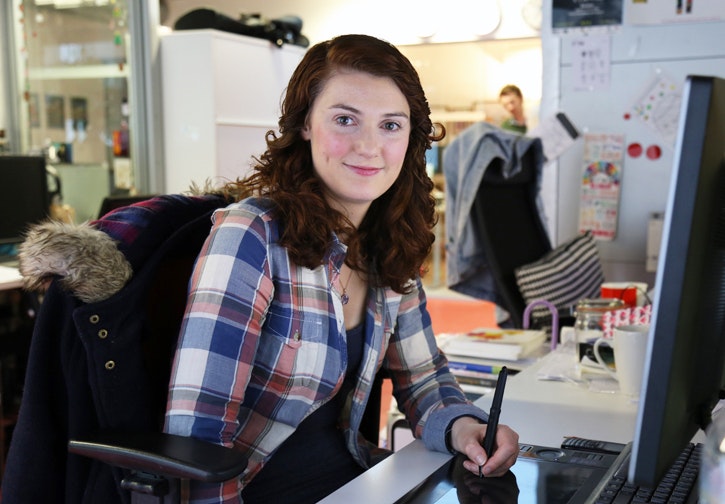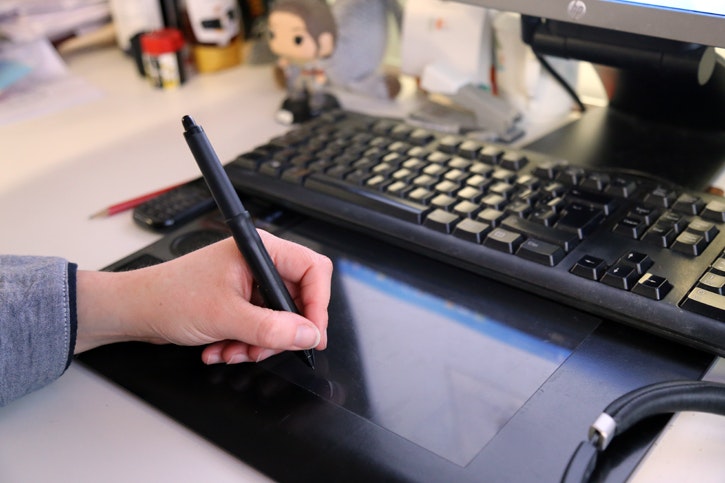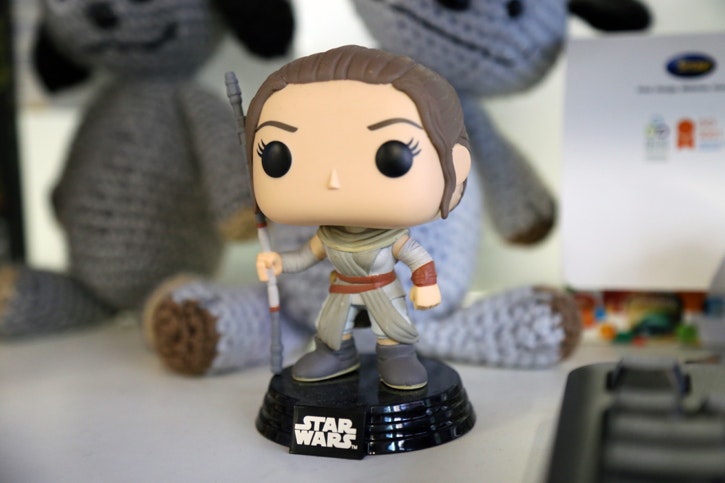Meet Storyboard Revisionist Cliona Curran #Interview
- Behind the Scenes
- Kids & Families
- Posted by Anahita Tabarsi on May 19 2016
Share Tweet
Meet Cliona Curran, our awesome Senior Storyboard Revisionist! Cliona started with us as an intern revisionist and dazzled us with her skills and professionalism! We caught up with her for a few minutes to discuss what her role involves and what she loves about animation.
How did you get into animation?
As a kid, I loved writing and sketching out stories. That interest never waned for me, so when I was picking college courses I applied for the Animation course in IADT Dun Laoghaire. I pulled together a portfolio from all my previous work in secondary school and was lucky enough to be accepted into the Animation course.
How long have you worked in the animation industry?
I’ve been working in the industry for 4 years on and off. I started off as an Intern Storyboard Revisionist for season 2 of Octonauts. My internship overlapped with my last year of college and lasted about 8 months. After finishing college, I stayed on as a Storyboard Revisionist and started working on Doc McStuffins season 2. Years later, I'm still working on Doc McStuffins, this time as a Senior Storyboard Revisionist for Season 4. In addition to my revision work, I've have also storyboarded full episodes for the Doc McStuffins series, which I am really proud of!

What's your current role and what does it involve?
My current role is Senior Storyboard Revisionist. There used to be a position called Storyboard Supervisor but that role and all its responsibilities has been split between the Senior Revisionist and the Episodic Director positions. The Senior Revisionist revises storyboards like revisionists but has more responsibility in terms of calling out deadlines for revision notes, allocating work out to other revisionists, co-ordinating with production/editors and Episodic Directors to make sure the revision side of the process is running as smoothly as possible.
A storyboard is the visual interpretation of a script drawn out in sequences of panels. The board first and foremost shows how the story will be played out. It must give everyone involved on the production a clear indication of the framing, blocking and posing/acting for the characters. The board must accurately make up the time of the show and not be under or over in length. Above all else, a good storyboard should take a script and interpret it visually, simply transferring the written word into drawings is not enough, it must embellish the script to serve the story as best as possible - so the storyboard artist has to have a lot of knowledge and interest in the following areas: cinematography, acting, editing, storytelling, life drawing, technical drawing. And they must also have a strong interest in directing.
Once a storyboard for an episode is finished, it is edited down/combined with sound to make what we call an Animatic. This is a Quicktime that allows the directors and the whole team to see what an episode will look like before production. Revisions are fixes on the current storyboard panels used in the animatic. The director, episodic directors and the client look at the animatic through 3 various stages. At each stage, revision notes are written up for the revisionists to do and once those are done the Animatic gets updated until finally it is locked.
Revision notes can be anything from cleaning up backgrounds, fixing up expressions/poses of characters to re-boarding entire sequences, sketching up new shots, changing camera angles on shots, reworking/choreographing dance routines for the episode. A revisionist would usually be expected to draw up to 80-100 panels a day, depending on the level of difficulty of the revision note.
If you are interested in becoming a storyboard artist, working as a revisionist on a show is a great way to start out. You are able to work on other storyboard artists' work and get a feel for their different styles and how they construct their boards. You also get to work closely with the episodic directors and learn what they want and need from a board.
This varies from show to show but in Doc McStuffins, revisionists work on Wacom drawing tablets and use Photoshop to redraw/draw the panels. Ultimately though the tools used are not important, all we really look for is a great visual narrative.

What was it like going from revisions to storyboarding episodes? What did you learn?
The transition from revising storyboards to storyboarding entailed a big learning curve. Luckily enough, I started small by splitting an episode of Doc McStuffins with another talented artist and former colleague, Robin French, who also wanted to storyboard. After that, I was more confident to take on a full one and then I kept taking them on to keep growing my skills.
On a full 11-minute animated episode, one would expect 17/19 pages of script. That would usually translate to 900/1200 panels so storyboards tend to be more functional than pieces of art. A board artist for Doc McStuffins would typically get 2 weeks to rough out the episode and then 2/3 weeks to address notes made on the rough board and to clean the board up.
Storyboard artists typically work from home and use their own software applications. Doc McStuffins uses board artists based internationally. I've worked on shows where the board artists have used Sketchbook Pro, Photoshop, Toomboom, and also old-school paper and ink! As long as the board is easy for production to crop and makes the deadline they are free to see what software application works best for them!
What are your biggest influences/inspirations?
The directors/episodic directors that I have worked with over the past few years, Dan Nosella, Damien O’Connor and Norton Virgien, have all been great influences in terms of my storyboarding! I would not have half the experience and training I have now if it were not for their guidance, patience, trust, critique and instruction in boards.
All of my lecturers in IADT, whose support in my creative growth greatly helped me in acquiring the internship here in Brown Bag.
I have just started a course in improv, which has greatly affected how I approach storytelling in a physical way and gives a great insight into characters and a new way to look at acting.
What’s your favourite tool to use and why?
For storyboarding and day-to-day revisions I use Adobe Photoshop. I have used other software to storyboard in the past such as Toomboom and Sketchbook Pro but I prefer Photoshop for its reliability and brush options. I will say that in terms of exporting panels I would use Toomboom.

What advice would you give someone considering getting into animation?
To people who are considering getting into animation or even storyboarding my advice would be: Be prepared for hard work and long hours. There is so much involved in animation/storyboards and it's very hands-on, so if you're not 100% committed or passionate it might not be for you.
Also drawing ability, while important, is less relevant than a clear, solid understanding of the language of cinema. When boarding you have unlimited choices in terms of camera placement, so you need to know whether a close up, a medium, a wide, a pan, a truck in, a truck out, etc., etc., etc., best serves the intention of the scene.
From my experience, I would also say that with regards to college projects, I found that finding something simple to work on and within my own interest was much more effective in terms of standing out and getting a complete project done than trying to make a masterpiece and do something big that might wow your colleagues but not finishing it on time. I’m not saying that pushing yourself is a bad thing but when you are starting out and want to learn, it is better to work smart so you will be able to finish a project.
What do you like most about working in animation?
With revisions and storyboards, I love that the work is never the same. I am solving different visual problems every day and I can confidently say that for the last 4 years I've been working, I've never had the same day twice!

What’s been the most challenging thing about working in animation?
Pressure and deadlines come hand in hand with the business. If any variable or part of the production is late then it can have a knock on effect further down the line, so there are occasionally crunch times. That also happens to be one of the joys, when the pressure is on, the team knuckles down and we always work through it, so there is a huge satisfaction when you see it all come together.
Outside of animation what are you most passionate about?
Outside of animation, I love to surround myself with story related things, I'm still very passionate about writing! All kinds of board games, dungeons and dragons (whenever I get a chance to play). I really enjoy improv acting, dancing and playing the guitar.
Are you interested in getting into animation? Keep an eye on our Behind-the-Scenes and Tutorials pages for more interviews, #Tutorials and #TopTips!
Anahita Tabarsi
Anahita is Brown Bag Films' Marketing Director, Digital & Social and drinks more than five coffees a day...
We Love Animation®
Brown Bag Labs is an exciting online space, brought to you by Brown Bag Films. We share great content for families as well as behind the scenes fun and tutorials from the Brown Bag Films team.



Get our great newsletter!
Get our great newsletter!